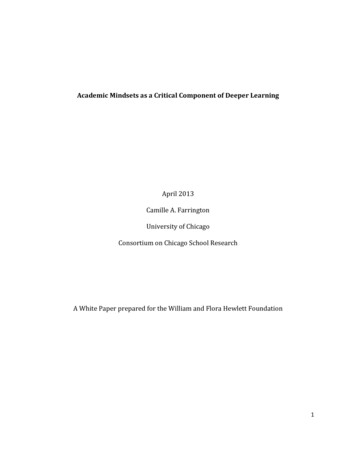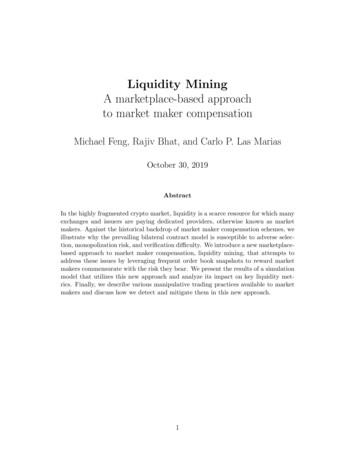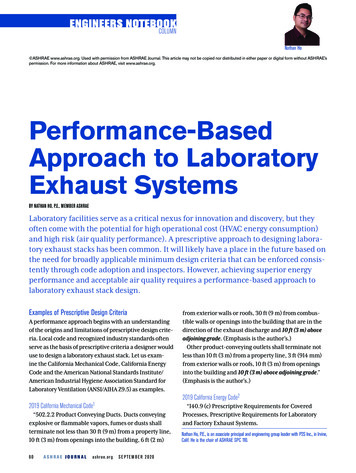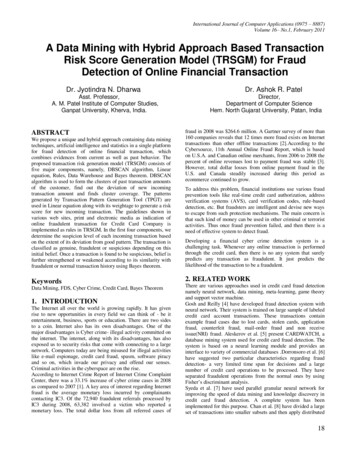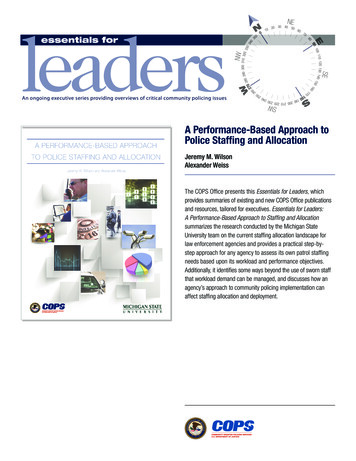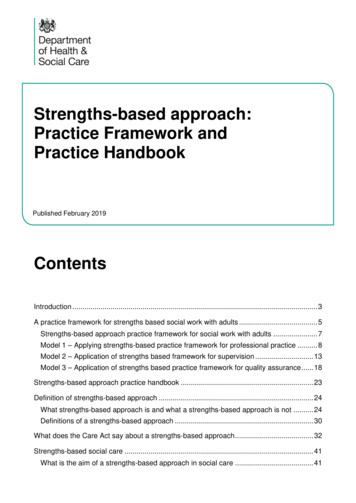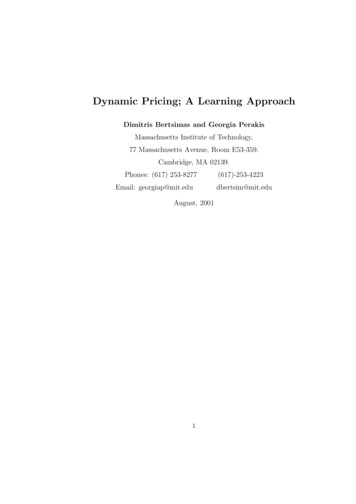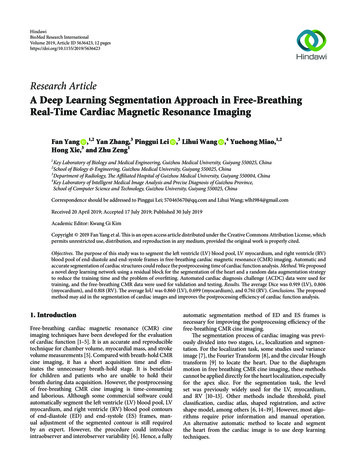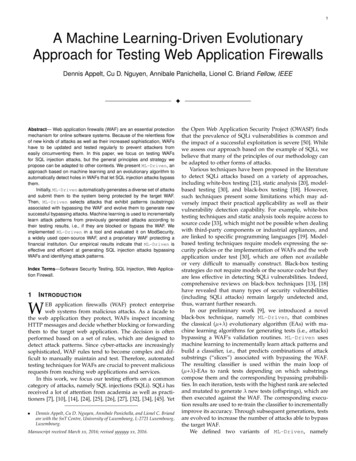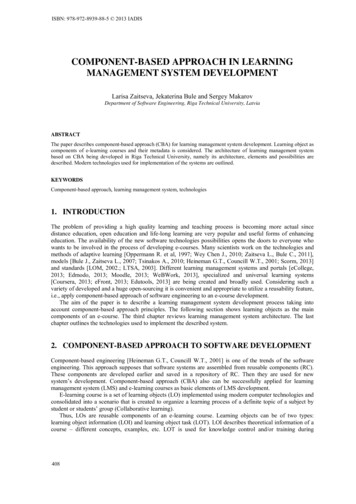
Transcription
ISBN: 978-972-8939-88-5 2013 IADISCOMPONENT-BASED APPROACH IN LEARNINGMANAGEMENT SYSTEM DEVELOPMENTLarisa Zaitseva, Jekaterina Bule and Sergey MakarovDepartment of Software Engineering, Riga Technical University, LatviaABSTRACTThe paper describes component-based approach (CBA) for learning management system development. Learning object ascomponents of e-learning courses and their metadata is considered. The architecture of learning management systembased on CBA being developed in Riga Technical University, namely its architecture, elements and possibilities aredescribed. Modern technologies used for implementation of the systems are outlined.KEYWORDSComponent-based approach, learning management system, technologies1. INTRODUCTIONThe problem of providing a high quality learning and teaching process is becoming more actual sincedistance education, open education and life-long learning are very popular and useful forms of enhancingeducation. The availability of the new software technologies possibilities opens the doors to everyone whowants to be involved in the process of developing e-courses. Many scientists work on the technologies andmethods of adaptive learning [Oppermann R. et al, 1997; Wey Chen J., 2010; Zaitseva L., Bule C., 2011],models [Bule J., Zaitseva L., 2007; Tsinakos A., 2010; Heineman G.T., Councill W.T., 2001; Scorm, 2013]and standards [LOM, 2002.; LTSA, 2003]. Different learning management systems and portals [eCollege,2013; Edmodo, 2013; Moodle, 2013; WeBWork, 2013], specialized and universal learning systems[Coursera, 2013; eFront, 2013; Edutools, 2013] are being created and broadly used. Considering such avariety of developed and a huge open-sourcing it is convenient and appropriate to utilize a reusability feature,i.e., apply component-based approach of software engineering to an e-course development.The aim of the paper is to describe a learning management system development process taking intoaccount component-based approach principles. The following section shows learning objects as the maincomponents of an e-course. The third chapter reviews learning management system architecture. The lastchapter outlines the technologies used to implement the described system.2. COMPONENT-BASED APPROACH TO SOFTWARE DEVELOPMENTComponent-based engineering [Heineman G.T., Councill W.T., 2001] is one of the trends of the softwareengineering. This approach supposes that software systems are assembled from reusable components (RC).These components are developed earlier and saved in a repository of RC. Then they are used for newsystem’s development. Component-based approach (CBA) also can be successfully applied for learningmanagement system (LMS) and e-learning courses as basic elements of LMS development.E-learning course is a set of learning objects (LO) implemented using modern computer technologies andconsolidated into a scenario that is created to organize a learning process of a definite topic of a subject bystudent or students’ group (Collaborative learning).Thus, LOs are reusable components of an e-learning course. Learning objects can be of two types:learning object information (LOI) and learning object task (LOT). LOI describes theoretical information of acourse – different concepts, examples, etc. LOT is used for knowledge control and/or training during408
IADIS International Conference e-Learning 2013acquisition of a course. LO has a complex structure and can be not just of various types (LOI and LOT), butalso of different kinds and parts within a type. Both for LOI and LOT the kinds are the same since a LOT issupposed to be used to evaluate knowledge and/or skill level on a definite LOI. So, the kinds are as follows:structure, definition, example and rule [Zaitseva L.V. et al, 1989], – depending on what exactly is beingdescribed in a LOI. As well there can be various parts for each LO: LOI – main, example, explanation. Example and explanation are optional LOIs of different detailinglevel; LOT – two parts: general task and individual task. The general task is the same for all students andindividual task is generated for each student separately to specify a general task. Every LOT according toa type has one or several answers, which are also referred as separate LO – LOA. As well there can beincluded comments for LOTs in general and every LOA particularly – LOC as well of different detailinglevel.In addition to LO’s complexity there is a list of metadata that should be considered while developing ane-course. The full list of LOs metadata is available in IEEE standard [LOM, 2002]. It is evident that all thedata is required to implement an e-course of high quality, but there is always more critical data that should betaken into account for different purposes (Table 1).Table 1. LOs metadataLO metadataLO title, description, language, platform,keyword, coverage/topic, type (LOI –main, example, explanation), specialty,program (study level – bachelor, master,college, etc.), purpose, copyright,restrictionsLO significance, mode of using (control,training), number of tries (LOT), time(acquisition – LOI or performing –LOT), type (LOI – main, example,explanation), difficultyLO representation (media), LOT’s type(multiple choice, word, number, etc.[Zaitseva L. et al, 2005]), languagePurposeThe initial list of reusable LOsto be included into an e-courseDescriptionThe main criteria to choosefrom the list of LOs availablein repositoryPossible minor modifications toadapt for an e-courseMeans just adaptation of theparameters,notexactlymodifications of LO itselfPossible major modifications toadapt for an e-courseLOI kind (definition, example, rule,structure), purpose, topic, LOT’s typeDecision on developing newLOsIt is consider as a majormodifications, if changing ofmedia or translation isinvolvedIn the case when there are noLOs of specific kind or ondefinite topic of a course, orthere are just one-type LOTsAs it was mentioned earlier, LOs are components of an e-course side by side with different processingprograms/modules. Thus, to apply component-based approach for LMS and e-learning course (ELC)development repositories of learning objects and program components are necessary.3. LEARNING MANAGEMENT SYSTEM ARCHTECTUREDifferent classes of users can use LMS. They are: student, tutor, e-learning courses author (ELCA),administrator, operator, but basic classes of users are first three. That’s why to present the architecture ofLMS (Fig. 1) we selected only three agents. LMS also has a main program module (kernel of a system) thatprovides users identification and connection to specified agent, a unified interface for all agents, organizationand maintaining of connection session, repository and databases maintaining, etc.409
ISBN: 978-972-8939-88-5 2013 IADISELCA agentTutor agentE-course developmentE-course reviewE-course testingMode definitionE-course dent agentLearningTeachingKnowledge controlStudent’sand group’sDBTrainingFigure 1. Learning management system architectureLearning objects and their metadata are saved in LO’s repository and can be used by ELC author todevelop e-learning course. Developed and tested ELC is saved in e-course’s database. A tutor after reviewingoffers it to students and/or groups of students. Students can use e-learning course for learning, teaching,knowledge control or training. Student’s and group’s database includes information about students andgroups of students, as well as a protocol describing a work with e-course.The main functions provided by ELCA agent are e-learning course development and testing. A processof an e-course development based on CBA consists of the five stages: 1) define a goal and objectives of thee-course; 2) develop the e-course scenario using information about LOs and their metadata saved in arepository. Usually a scenario of an e-course is represented as a graph with LОs as vertexes and edges showthe connections types between them [Zaitseva L., Bule C., 2011]; 3) select necessary learning objects from arepository and check them. An analysis and reviewing of the selected learning objects is performed duringthis stage to find out whether they fully correspond to the goal and objectives of the e-course, as well as tomake a decision on each LO: to use it with no modifications; edit it adapting to the e-course requirements;develop fully new LО(-s); 4) modify the selected LОs, develop new LОs and test them. Modifications can beas follows: add new information to LO, remove unnecessary information according to the e-course authorand/or represent existing information by means of other media; 5) integrate LОs into the e-course accordingto the scenario developed in the stage 2. The next step is testing of the e-course in general. Afterwards it isplaced into e-course’s DB. If during and ELC development the new LОs were created or modified theexisting ones, author can save them in a repository.The function „E-course statistics” allows author to get information about students work with ELC. Afteranalyzing it author can improve a quality of an e-course by making some modifications, for example, addingmore detailed representation of learning information with new examples or specifying a text of a task.410
IADIS International Conference e-Learning 2013The Tutor agent provides the following functions: E-course review. Before making an ELC available for students tutor has to test it and evlauate it’scorrespondance to goals and tasks of a subject taught as well to make a decision on expoliting it withoutany modifications or make some amendments, for example, add more examples, questions and/or tasks.In the last case a copy of an e-course with tutor made changes is saved in e-course’s DB. Mode definition. Depending on a chosen strategy of an ELC using [Zaitseva L., Bule C., 2011] tutor canset paramateres of a course exploiting that are usually specified for a group of students. For example, anELC is supposed to be used for totally unassisted learning, training or knowledge control. For knowledgecontrol (KC) it is possible to determine KC method, a number and difficulty levels of tasks, etc. [ZaitsevaL.V. et al, 1989]. Statistics. This function allows a tutor the possibility to get the detailed information about student workresults.The Student agent ensures a work in four modes for students: Learning. This mode gives student a possibility to learn independently any course that is available in ecourses’ DB, using Teaching, Knowledge control and/or Training. Teaching. The mode provides an e-course teaching that was assigned by a tutor according to developedscenario. Knowledge control (КС) is used to test and evaluate students’ knowledge and skills level. If the mode isassigned by tutor, a student answers questions and performs tasks according to set control parameters. Ifthe КС is chosen by student to test own knowledge and skilss level (self-control) then he/she can chooseas well a number of tasks, difficulty level and detailing of comments. Training is supposed for mastering skills on tasks solving on chosen or assigned by tutor topic. In thiscase it is the best practice to provide detailed comments on every student action.Learning management system includes also various supplementary program components (modules) toensure learning and teaching functions, namely: module for choosing tasks from similar ones to ensure thatstudents get different questions during learning process; module for generating input data and calculatingresults while tasks performing and solving calculation assignments and others.4. TECHNOLOGIES FOR LEARNING MANAGEMENT SYSTEMIMPLEMENTATIONConsidering complexity of e-learning system architecture, it is implemented based on a multi-layer structure,which is standard for modern business software. System itself is based on web technologies since it is themost efficient way to deliver content. As well they have developed dramatically recently and allow simpleprocessing of all kinds of information used in e-learning process. Client side is a browser-based user interfacewith all functionality needed to show all e-learning components for user, while server side contains allprocessing logic and databases/repositories.Client side realized by using current web technology standard: Ajax, which allows dynamically changingcontent depending on input and reducing processing requirements on server, and considering increasedrequirements for security, Secure Socket Layer (HTTPS protocol) is a “must have” technology. To designuser-friendly interface (UI) cross-browser integration framework should be used – jQuery [jQuery, 2013],Prototype/Scriptaculous [Prototype, 2013; Scriptaculous, 2013], MooTools [MooTools, 2013], Dojo [Dojo,2013]. One of the most optimal frameworks for client side is MooTools, which ensures such an UI renderingthat it looks the same on every popular browser currently on market.Server side implements business logic and DBMS system. Considering a length of a life-cycle ofsoftware, five to seven years, technologies used in business logic implementation must be solid, i.e., havelong history of support and without major changes in syntax through version history and with a big enoughcommunity of developers, like Java, .Net, PHP. Therefore server side logic is performed on Java, which hasefficient integrated environments also there are a lot of frameworks available. As well one of the advantagesis that almost everything is for free, so development costs are highly reduced. Taking into account that OSGicontainer [OSGi, 2013] is used for different modules, the GlassFish Java server [GlassFish, 2013] waschosen for providing a performance of LMS. OSGI allows separating some logic and functionality, and alsodynamically adding new content to server.411
ISBN: 978-972-8939-88-5 2013 IADISTo ensure data storage in repositories DBMS PostgreSQL is employed since it it’s free, open-source,highly customizable and has powerful
The paper describes component-based approach (CBA) for learning management system development. Learning object as components of e-learning courses and their metadata is considered. The architecture of learning management system based on CBA being developed in Riga Technical University, namely its architecture, elements and possibilities are
